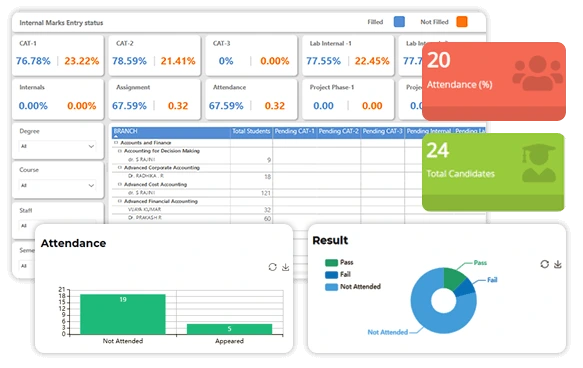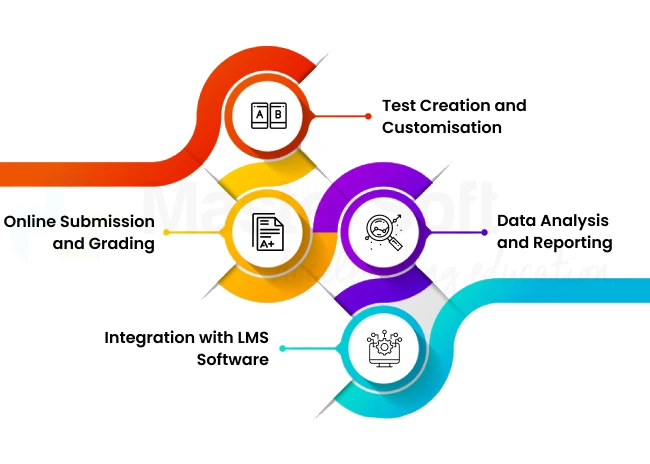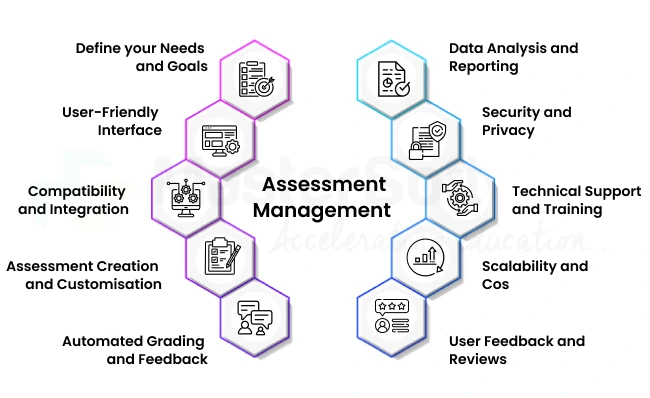
12, June 2023
Technology innovations continue to influence how students study and professors teach in the fast-paced world of education. The introduction of Assessment Management Software represents a significant development in this area. The assessment procedure for students will be streamlined by this software, enabling a more thorough, accurate, and thorough evaluation of their academic development.
Importance of Assessment Management Software
Assessment management software plays a major role in the educational sector as it helps to streamline the assessment process. For teachers, AMS frees up time by automating processes like test creation, distribution, and grading. It offers a centralised platform for data analysis and storage, enabling instructors to learn about student performance and make strategic instructional decisions.

Online Assessment Test – How Does It Help You Keep Track Of Student's Progress?
By defining specific evaluation standards and maintaining uniform assessment procedures, the assessment management software encourages fairness and standardisation. Additionally, it improves flexibility and accessibility by allowing students to complete assessments online, opening up possibilities for inclusive and self-paced learning. It further helps with effective assessment management, data-driven decision-making, and better educational outcomes.
Key Features of Assessment Management Software

Test Creation and Customisation:
The software offers a user-friendly interface for teachers to create assessments quickly. It allows for flexibility in question types, including fill-in-the-blanks, multiple choice, essays, and more. Also, educators can easily customise the parameters of each test, such as time limits, randomization, and difficulty levels.
Online Submission and Grading:
The system eliminates the need for physical paper submissions by providing a digital platform for students to complete and submit their tests and assignments. It also provides immediate feedback to students, allowing them to track their progress and identify areas for improvement.
Data Analysis and Reporting:
Teachers can easily generate comprehensive reports and analyse student performance data. They can obtain valuable insights into individual and overall class performance, identifying strengths and weaknesses. This data-driven approach empowers them to make informed decisions regarding curriculum design and personalised learning strategies.
Integration with Learning Management Systems (LMS):
The software can be integrated with other ERP software, such as LMS. This integration allows for smooth synchronisation of data, centralised access to assessments, and simplified management of student accounts. It further provides a unified platform where students can access course materials, complete assignments, and engage in interactive learning activities.
MasterSoft's Outcome-Based Assessments: Easy Accreditation For Institutional Growth
Benefits of Assessment Management Software
- Enhanced Efficiency: The software automates time-consuming tasks such as grading and data entry, enabling instructors to focus more on personalised teaching and student engagement. Moreover, it saves substantial time and effort, particularly in large classes or institutions with multiple courses.
- Personalised Feedback: The assessment management system facilitates immediate feedback for students, fostering a more individualised and tailored learning experience. Students receive timely feedback on their assignments and tests, allowing them to understand their strengths and weaknesses, address doubts, and make necessary improvements.
- Improved Accessibility: The online assessment platform promotes accessibility by providing students with the flexibility to complete assessments remotely. This is particularly beneficial for learners with physical disabilities or those in remote locations. Additionally, it allows students to review their assessments at any time, promoting self-paced learning.
- Data-Driven Decision Making: The data generated by online assessment management systems empowers teachers to make data-driven decisions, ensuring targeted interventions and personalised teaching. By identifying patterns and trends in student performance, instructors can adapt their teaching strategies to optimise learning outcomes.
Challenges of Assessment Management Software
While assessment management systems offer numerous advantages, there are certain challenges to consider:
- Initial Learning Curve: Transitioning to a new online assessment platform requires training and support for both teachers and students. Institutions need to invest time and resources in ensuring a smooth transition and providing ongoing technical support.
- Technical Issues: As with any software, technical issues may arise, potentially disrupting the online assessment process. It is crucial to have robust technical support in place to address any glitches promptly.
- Security and Privacy: Protecting student data and maintaining privacy are of utmost importance. Schools and colleges must ensure that the online assessment management software adheres to stringent security measures and complies with relevant data protection regulations.
- Equity and Access: While the software provides enhanced accessibility for many students, it is important to consider potential disparities in internet access and digital literacy among student populations. Institutions must provide support and resources to ensure equitable access for all learners.
Additionally, Assessment Management Software is perfectly in line with the objectives and guiding principles of NEP 2020, the National Education Policy. This software offers a strong framework to meet these goals given the NEP's emphasis on holistic and ongoing assessment. It enables educators to create interesting and unique tests that include many facets of a student's growth outside of academic success.
Furthermore, it enables ongoing evaluation and feedback, enabling teachers to monitor development, spot learning gaps, and offer tailored support. Educational institutions can successfully implement the assessment reforms suggested by the NEP by integrating assessment management software into their assessment practices, fostering a thorough and learner-centric approach that encourages holistic development and improved learning outcomes for students.
How to Choose a Suitable Assessment Management Software for Your Institute?
Below are factors that must be considered while selecting an ideal online assessment platform for students:

Define your Needs and Goals:
Start by clearly defining your institution's needs and goals. Consider the specific requirements of your student population, the types of assessments you typically administer, and the desired outcomes you aim to achieve. This will help you narrow down your options and select software that aligns with your objectives.
User-Friendly Interface:
An intuitive and user-friendly interface is essential for both educators and students. The software should have a straightforward and visually appealing design, making it easy to navigate and use. Consider the ease of creating assessments, administering them, and accessing the results. A well-designed interface reduces the learning curve and promotes seamless interaction with the software.
Compatibility and Integration:
Assess the compatibility of the software with your existing ERP solutions. Check if the software integrates smoothly with your Learning Management System, Student Information System, or other relevant platforms. Integration with other systems streamlines data synchronisation, reduces administrative efforts, and enhances the overall user experience.
Assessment Creation and Customisation:
Evaluate the features and capabilities of the system for test creation and customisation. Look for a wide range of question types and the ability to customise parameters such as time limits, randomization, and difficulty levels. Consider whether the software supports multimedia content integration and advanced assessment formats that align with your educational objectives.
Automated Grading and Feedback:
Assess the grading capabilities of the software, including the accuracy and reliability of the automated grading algorithms. Ensure that the software provides meaningful and timely feedback to students, helping them understand their performance and areas for improvement.
National Education Policy 2020 - Make Your Institute Ready For NEP-2020
Data Analysis and Reporting:
Select a platform that offers robust data analysis and reporting features. It should allow educators to generate detailed reports on individual and class performance, analyse trends, and identify areas that need attention. Look for features such as visual dashboards, analytics tools, and customizable reporting options that facilitate data-driven decision-making.
Security and Privacy:
Data security and privacy are crucial considerations when selecting an assessment management system. Ensure that the software complies with relevant data protection regulations and implements strong security measures. Also, evaluate the software's data encryption protocols, access controls, and the vendor's commitment to maintaining the confidentiality of student information.
Technical Support and Training:
Consider the availability and quality of technical support and training resources provided by the ERP vendor. Determine whether they offer comprehensive training resources, documentation, and tutorials to help educators and students navigate the software effectively. Prompt and reliable technical support is vital to address any issues or concerns that may arise during the implementation and usage of the AMS.
Scalability and Cost:
Assess the scalability of the system to accommodate your institution's current and future needs. Consider the number of students and teachers it can support, as well as the scalability options provided by the vendor. Additionally, evaluate the cost structure of the software, including licensing fees, maintenance fees, and any additional charges for premium features. Compare the costs against the value and benefits offered by the AMS.
User Feedback and Reviews:
Seek feedback and reviews from other educational institutions or colleagues who have experience with the assessment software you are considering. Their insights can give valuable information about the software's strengths, limitations, and user satisfaction. Additionally, explore online communities, forums, and review platforms to gather a wider range of perspectives.
In Conclusion,
Assessment management software is a game-changer in the education landscape. It revolutionises the way assessments are conducted and boosts educational efficiency with its automated grading, thorough data analysis, and personalised learning elements. By using this software, educational institutions can promote collaboration, support continuous development, and create a more inclusive and interesting learning environment.
Moreover, the benefits of AMS go beyond exams, allowing teachers to track student progress, link assessments with learning objectives, and involve parents and other stakeholders in the educational process. It is not just a tool but a catalyst for educational transformation, unlocking the full potential of both educators and students.
Secure and Robust Online Assessment System for Seamless Exam Conduction!
Mobile: 08448010216
Email:info@mastersofterp.com


















.jpg)